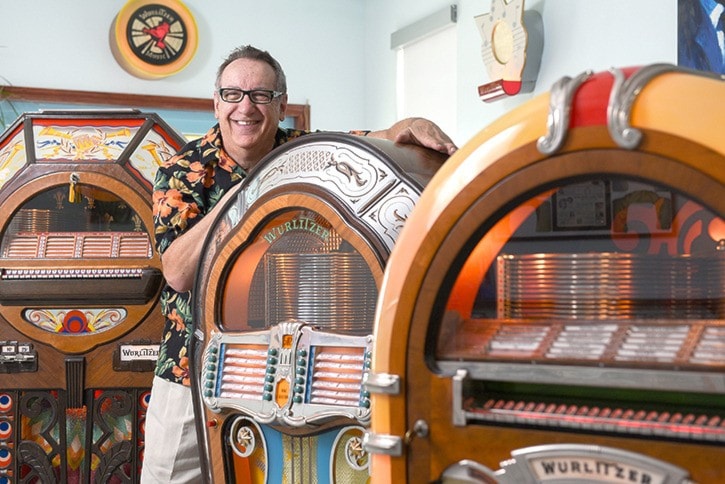It was – as the old songs say – love at first sight.
White Rock's Gerry Parson still remembers the day – more than 30 years ago – when he saw his first jukebox up close in all its coloured-bakelite, bubble-lighted glory.
"I was attending Dalhousie Law School in Nova Scotia and came back to B.C. for Christmas," the avid collector and restorer recalled.
"I was meandering down Main Street and, in an antique store, I saw a 1941 Wurlitzer."
He didn't know anything about them at the time, he said – but he did know that he had received a second term student loan disbursement only two days earlier.
"Need I say more? The jukebox came home with me," said Parson – an affable bespectacled man who is almost as identifiable by his trademark multi-coloured tropical shirts as he is by his treasured collection of coin-operated wonders.
One of those people who, by nature, loves taking things apart to see how they work – "I like playing with stuff with my hands," he said – Parson lovingly restored that first jukebox to pristine condition himself.
A fellow owner saw the results of his work, and commissioned Parson to restore his machine. Before long, he was getting calls from other collectors who wanted him to restore their jukeboxes too.
Though he graduated law school in 1986, the lure of fiddling with yesterday's musical marvels soon outweighed the prospect of poring over legal tomes, he confessed.
"I thought 'I'll do this for a year or two and go back to law'," he said. "It never happened."
Thus was Golden Age Jukes born – a White Rock-based business in which Parson became a go-to man for restoring, reconditioning and selling vintage jukeboxes for close to 30 years.
Over that time, he turned careful refinishing of each and every movable part, hand-adjusting action and tone-arm weights, replacing needle cartridges and repairing mellow-sounding tube amplifiers – not to mention colour-matching vintage plastic sections and veneers – into a virtual art form.
"It was a hobby that turned into a business and went back to being a hobby again," said Parson, who, while he still conducts maintenance and repairs for long-term clients, considers himself retired now.
But his love affair with the jukeboxes themselves has not diminished – as witness his invited role in a new exhibition at the Museum of Vancouver.
All Together Now: Vancouver Collectors and Their Worlds opened Thursday at the museum (1100 Chestnut Street in Kitsilano, continuing until Jan. 8) and the cream of Parson's current collection of seven of the venerable music-dispensers is there – along with some of the other weird and wonderful things that people amass, among them toys and action figures, pinball machines and Vancouver public transit ephemera – even vintage artificial limbs.
It's interesting, as MOV curator of contemporary culture Viviane Gosselin points out, that the collecting community is dominated by males by a ratio of nine-to-one – it's been theorized that the urge is hard-wired into the masculine psyche as part of a hunter-gatherer heritage, although it may just be that men simply make better nerds than women.
But Parson, like the other 19 enthusiasts whose hobbies are spotlighted, doesn't seem too bothered about the whys and wherefores of his obsession.
And the gorgeous contraptions he collects are inarguably 'cool' – indeed, to many retrophiles, they seem a quintessential 'Fabulous `50s' icon, along with Elvis' sideburns and Marilyn's subway-billowing white dress.
Parson gets a chuckle out of that – as much as he loves `50s music (and owning Golden Age Jukes led to personal encounters with many stars of the decade including Jerry Lee Lewis and Brenda Lee) he knows that the classic late art deco, cathedral-style Wurlitzers he collects actually belong to the earlier era of swing bands and romantic crooners that started in the 1930s and wound up in the late 1940s.
The turning point in jukebox history, he said, came around 1950, when Wurlitzer's chief competitor, Seeburg, introduced a machine that held 100 45 rpm discs – compared with a maximum two-dozen 78 rpm selections in the Wurlitzer.
In the cut-throat, competitive world of the operators who leased the machines to restaurant and cafe owners – and took a substantial rake-off of the contents of the change-boxes – the novelty of quantity took precedence over quality, Parson said, and the ornate charms of the top-of-the-line Wurlitzer became passe overnight.
Not for Parson, of course, who admits that it was the technical and visual appeal of Wurlitzer's machines that ultimately led him to his love of all kinds of music from the past – and his present, almost encyclopedic knowledge of the history of coin-operated recorded music.
And his eyes still get a certain glow when he expounds on their enduring glamour.
"The ones I really got attracted to were from the `40s – their styling was amazing. Wurlitzer had about six models. They were the only ones with the bubble tubes as well as rotating colour cylinders," he said.
"Part of the attraction to solicit the nickel from a patron was that you didn't get the full effect until you made a selection. That not only triggered the music, but flipped on a bunch of other lights, so the patron got a visual experience as well as a musical one."
For more information about MOV and the current exhibit – including opening hours – visit www.museumofvancouver.ca
